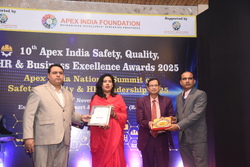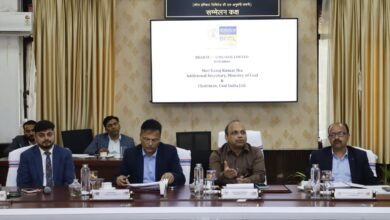Proposal To Monetise CPSU Land Assets Is Legally Unsustainable And A Mindless Privatisation Exercise!
People’s Commission’s Statement on the Centre’s proposal to monetise CPSU land assets

The People’s Commission has taken note of the decision taken by the Union Cabinet in March 2022 for “setting up National Land Monetisation Corporation (NLMC) as a wholly owned Government of India company with an initial authorised share capital of Rs 5000 crore and paid-up share capital of Rs 150 crore. NLMC will undertake monetisation of surplus land and building assets of Central Public Sector Undertakings (CPSUs) and other Government agencies”
According to the official Press Release dated 9-3-2022 issued by the government, the purpose of land asset monetisation is “to generate substantial revenues” for the government.
The Commission had earlier examined the issue of monetisation of CPSU lands in some detail in their Interim Report released in November, 2021 and cautioned the government of the pitfalls in such a move. Despite our cautionary advice, it is unfortunate that the government, in its rush to sell CPSUs and their valuable assets, should proceed to monetise the CPSU land assets.
Legal Implications:
Land acquisition legislation of 1894
The proposal to monetise the CPSU land assets is legally unsustainable in the first instance.
As already indicated in our Interim Report cited the lands acquired for the CPSUs in the past were forcibly acquired from the original land owners, many among whom were farmers, under the erstwhile 1894 land acquisition legislation and handed over to the CPSUs at rates far lower than the market rates. Under that legislation, the acquisition was made on the specific ground that the lands were meant for a “public purpose”, a term defined under that law [Section 3(f)(iv) of the 1894 Act] as ” the provision of land for a corporation owned or controlled by the State;”. In fact, when the States invoked their “eminent domain” authority under that legislation, they gave an explicit commitment to the landowners that their lands would be utilised by entities owned or controlled wholly by the State. Any basic alteration in this premise would be tantamount to a breach of trust reposed by the land owners in the State, apart from its being prima facie illegal. Once the nature of ownership and control of the land shifts from the hands of an entity owned or controlled by the State to a private company, the premise on the basis of which the lands were acquired from the original landowners would stand altered, rendering the transaction legally untenable. Strictly, as and when there is an alteration in the nature of ownership or control of such lands, the lands should automatically revert to the State and, from the point of view of equity and justice, they should revert to the original landholders.
While it is a fact that the 1894 land acquisition legislation has since been replaced by the 2013 legislation, the legal position indicated above would continue to be applicable, as the definition of “public purpose” as defined in Section 3(f)(iv) of the 1894 legislation cannot be deemed to have been retrospectively altered, since such retrospective application would prejudice the interests of the original land owners and the legislative intent as applicable at that time.
Asset monetisation implies that the lands are handed over to a private company that would put it to commercial use to generate revenues, a share from which would accrue to the State. In other words, asset monetisation per se involves a change in ownership (even if it is temporary) and a change in control of the lands, which attract the legal infirmity cited above. As such, the idea of CPSU land monetisation is legally not permitted.
The special case of privatisation of the CPSUs/ monetisation of their land assets in the Scheduled Areas:
Many CPSUs have their facilities and operations located in areas which stand notified under the Fifth Schedule to the Constitution, which confers special rights on the local tribal communities. In those areas, the provisions of the Panchayats (Extension to the Scheduled Areas) Act, 1996 [PESA] are applicable. PESA empowers the local tribal Gram Sabhas to take decisions on programmes, schemes, projects and all such matters that affect the lives of the tribals. Prior consultation with the Gram Sabhas and their prior consent is a mandatory requirement for either the Centre or the State taking decisions in such matters. Moreover, alienation of the lands located in the Scheduled Areas to private agencies, as stipulated by the apex court in 1997 in the Samatha case, would be illegal. Therefore, any decision to disinvest a CPSU or monetise its land assets, to the extent they are situated in a Scheduled Area, would be legally invalid.
To cite one example of this, the Union Ministry of Finance has proposed NMDC’s Nagarnar Steel Plant for disinvestment. For this purpose, the plant is being de-merged from the CPSU into a separate company. Both the core and the non-core land assets of the company are located in the Scheduled Area of Chhattisgarh State. It would be illegal for the Centre to monetise either the core or the non-core lands of the steel plant.
Railway lands:
While the legal issues cited above are applicable in all cases, in the specific case of the Railways, large extents located along the tracks in and around urban agglomerations, are under the occupation of millions of low-income families, mostly belonging to the SCs/STs/OBCs, engaged in marginal occupations with meagre livelihoods. They are mostly migrants from rural areas coming to cities and towns in search of employment. While they are engaged in many essential activities such as providing services for construction works for the Railways, services for the passengers, auxiliary occupations that support the urban population etc., the local municipalities and the other local bodies have failed to rehabilitate them properly, forcing them to occupy government lands including railway lands. The locations where they have set up their make-shift shelters are such that they are close to the places (e.g railway stations) where they earn their livelihoods. The Railways are reported to be making plans to treat them as “encroachers” and evict them to facilitate monetisation of the lands through Public Private Partnerships. Under Article 21 (Right to Life), such occupants have a right to continue in situ, unless the Railways, with help from the concerned States, can arrange alternate sites for their rehabilitation so that they may have access to better facilities and improved livelihoods to be able to live in dignity. Until then, they should not be evicted. On the other hand, as already stated, even otherwise, it would not be legally justified for the Railways to monetise the lands by alienating them to private companies.
If the government chooses to ignore this and proceed to monetise the CPSU and Railway lands, it would most likely lead to avoidable litigation that would cost the Indian tax-payer dearly.
Need for a wider discussion:
Since the CPSUs were set up in the past and they have evolved into symbols of self-reliance over the decades by the assiduous efforts put in by successive governments, a precipitate and a unilateral decision on the part of the Centre to sell them and their valuable assets to private companies in an undue haste would not be prudent. Such proposals need to be discussed and debated widely both in the Parliament, in the State legislatures and among the public at large.
There are other equally important public concerns that arise from CPSU land monetisation.
States are an important stake-holder:
Since the CPSUs were set up on the lands acquired by the States and since it was the States that played a pivotal role in developing complexes of auxiliary industries around them and actively involved in maintaining a congenial environment for the welfare of the workers, they have a significant stake in the CPSUs, as much as the Centre. Therefore, the Centre cannot unilaterally decide to privatise the CPSUs or to monetise their land assets. The States have a legitimate claim to a stake in the value of the land under occupation of the CPSUs. It is unfortunate that the Centre should ignore the States and rush headlong into such a distress sale of the CPSUs and their valuable assets.
The present-day market value of the CPSU lands is quite high, as there has been all round development around the CPSUs with numerous auxiliary industrial clusters coming up in their vicinity and residential complexes springing up. In fact, the market value of the CPSU lands would continue to rise steeply as further development takes place around them. When a CPSU is privatised or its lands monetised, in an environment in which such land is becoming more and more scarce and its value skyrocketing, the lease/sale proceeds that accrue to the government invariably tend to be far less than their potential value.
In almost all the CPSUs, there are expansion plans ready and the so-called “surplus” or “non-core” lands would be required in the coming years for such capacity expansion. Therefore, it would be misleading to call those lands ‘surplus”.
Proceeds from disinvestment or asset monetisation do not provide additional fiscal resources:
The Commission had pointed out in their Interim Report that the justification cited by the government that privatisation of the CPSUs or monetisation of their lands would fetch “additional fiscal resources” is an ill-conceived idea as the so called “additional” proceeds from privatisation should necessarily be raised by private companies from the same pool of savings in the economy from which the government also borrows. The terms on which a private company can raise resources would be necessarily less advantageous compared to the terms on which the government as the sovereign can borrow. In other words, if the government choses to adopt the circuitous route of raising funds via CPSU disinvestment, the funds so raised would be on less advantageous terms compared to the terms on which it could raise the same by directly borrowing from the market. In fact, considering the fact that neither privatisation of the CPSUs or monetisation of the CPSU lands would be commensurate with their potential value, even in terms of absolute amounts, raising funds through such a circuitous route would be less advantageous. In view of this, there is no justification for the government to resort to privatisation or asset monetisation as the means to raise additional resources, considering that such privatisation would also entail the government losing its ownership/ control of the CPSUs/ their assets.
How the government has chosen to embark on a large-scale privatisation/ asset monetisation over a compressed time span has resulted in literally putting the public assets to a distress sale, which is a matter of grave concern.
Many CPSUs, especially those in the oil sector, have better credit rating compared to the private companies in whose favour their assets are sought to be alienated in the name of monetisation. In case those CPSUs need additional funds, they could raise funds directly from the market, instead of going through the route of asset monetisation, as the terms on which they can raise resources would be far better. The government, in our view, should not misuse the CPSU lands to raise funds for the reasons already stated.
The idea of raising additional fiscal resources for the government arises from the fiscal stress on the Union Budget. We feel that the answer to this lies elsewhere.
In the first instance, the government should address the need to prune its expenditure on non-essential items to reduce the fiscal gap. On the revenue front, the fact that income inequalities have increased and there is a greater concentration of wealth today than ever before, the government should introduce higher taxes including a higher wealth tax, in fulfilment of its welfare obligations laid down in the Directive Principles, to raise the level of revenue generation. Without exploring these legitimate options, it would be highly imprudent for the government to look upon privatisation or asset monetisation as the means to raise resources. A cursory look at the trends in the Union Budget shows that the bulk of the fiscal deficit is contributed by galloping interest liabilities. Instead of containing the level of borrowings, what the government is seeking to do at present is to raise resources for meeting the additional interest liabilities rather than raising resources for increasing investment in essential public welfare sectors such as health, education, social justice and so on. By reducing expenditure on non-essential items and raising resources from differential and compensatory taxation to reduce wealth and income inequalities, the government should be able to find resources for public expenditure on essential items.
The experience of several other countries with asset monetisation has not been quite encouraging and the government is advised to examine the same and draw useful lessons.
In particular, we refer to the considered views of Rod Sims, the Australian Competition and Consumer Commission Chairman, who cautioned his government not to rush into such an approach without adequate realisation of the huge costs involved.
The fact that the Centre has been somewhat indiscriminate in hastily selling the CPSUs is more than amply borne by the embarrassing outcome of two recent cases of disinvestment, one of the Central Electronics Ltd. (CEL) and another of Pawan Hans, in which, as a result of gross non-application of mind and an outright absence of due diligence, the bidders selected were of highly questionable antecedents. At the last minute, the government had to put the disinvestment exercise on hold. These two cases corroborate the cautionary advice rendered by the Commission not to rush into such a mindless privatisation exercise.
In conclusion, the Commission would call upon the Centre to suspend forthwith CPSU privatisation and monetisation of the CPSU land assets. The Centre is well advised to prepare a white paper on the pros and cons of privatisation and place the same before the Parliament and the public for a wide discussion. Such a white paper should also be made available to the States for initiating a similar discussion in the State legislatures.
People’s Commission on Public Sector and Public Services
About Peoples’ Commission on Public Sector and Public Services (PCPSPS): Peoples’ Commission on Public Sector and Services includes eminent academics, jurists, erstwhile administrators, trade unionists and social activists. PCPSPS intends to have in-depth consultations with all stakeholders and people concerned with the process of policy making and those against the government’s decision to monetise, disinvest and privatise public assets/enterprises and produce several sectoral reports before coming out with a final report. Here is the first interim report of commission- Privatisation: An Affront to the Indian Constitution.
This article is based on a press release issued by Peoples’ Commission on Public Sector and Public Services




